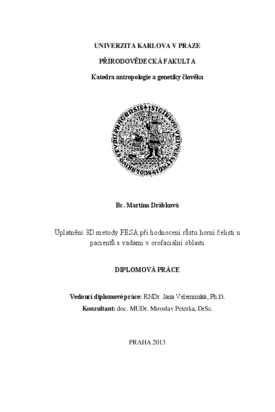Uplatnění 3D metody FESA při hodnocení růstu horní čelisti u pacientů s vadami v orofacialní oblasti.
Application of 3D FESA method in evaluation of the maxillary growth in patients with defects in the orofacial region
diplomová práce (OBHÁJENO)

Zobrazit/
Trvalý odkaz
http://hdl.handle.net/20.500.11956/52785Identifikátory
SIS: 82095
Kolekce
- Kvalifikační práce [19606]
Autor
Vedoucí práce
Oponent práce
Sedlak, Petr
Fakulta / součást
Přírodovědecká fakulta
Obor
Antropologie a genetika člověka
Katedra / ústav / klinika
Katedra antropologie a genetiky člověka
Datum obhajoby
12. 6. 2013
Nakladatel
Univerzita Karlova, Přírodovědecká fakultaJazyk
Čeština
Známka
Výborně
Diplomová práce sledovala longitudinální růstové změny povrchu patra včetně alveolárních výběžků a jeho variabilitu v rámci analyzovaného souboru 14 pacientů s celkovým jednostranným rozštěpem rtu a patra (UCLP). K hodnocení bylo použito celkem 28 dentálních sádrových odlitků získaných od každého z pacientů v průběhu dvou vyšetření, vždy před operací rozštěpu rtu a následně po ní. První odlitek byl pořízen v průměrném věku 6 měsíců, zatímco průměrný věk pro snímání druhého odlitku byl 4,5 roku. Dentální odlitky byly nejprve naskenovány 3D laserovým scannerem a poté zpracovány prostřednictvím metod geometrické morfometrie. Hlavním cílem bylo posoudit možnost uplatnění námi zvolené metody FESA k analýze tvarově odlišných povrchů pater tvořených dvěma samostatnými maxilárními výběžky. Individuálním a komplexním hodnocením růstových změn tvaru a velikosti povrchu alveolárních výběžků a patra UCLP pacientů bylo zjištěno, že v průběhu sledovaného období dochází zejména v anteriorní části obou segmentů k jejich vzájemnému přibližování za současného zužování šíře rozštěpové štěrbiny. Růst probíhá především v posteriorních částech obou maxilárních výběžků, nejvýraznější změny velikosti a tvaru pak odpovídají místům nově vznikající dentice. Prostřednictvím analýzy hlavních komponent (PCA) bylo provedeno...
Thesis deals with the study of the longitudinal growth changes of the palate including alveolar pocesses and its variability within the analysed group of 14 patients with UCLP. 28 dental plaster casts obtained from each patient in the two examinations (always before and after the cleft lip surgery), were used for the evaluation process. The first dental plaster cast was taken from patient with an average age of 6 months, while the average age for second continuous casting was 4,5 years. Dental casts were scanned using a 3D laser scanner and then analysed, using methods of geometric morphometrics. The main aim of this study was to evaluate the possibility of FESA application for the analysis of palates with different shapes consisting of two separate maxillary segments. Individual and complete evaluation of the growth changes of palate alveolar processes and palate in patients with UCLP showed that during the monitored period, mutual approximation while narrowing the width cleft occurs, mainly in the anterior part of both maxillary segments. Growth occurs primarily in the posterior parts of both maxillary segments, the most significant changes in the size and shape then correspond to places where new dentition arise. Complementary assessment of size and shape variability of alveolar processes and palate in...
